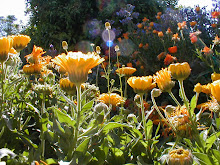Although these bulbs look like they were dug up from the earth, the round bulb is a swollen stem that grows above ground. Not a commonly used vegetable in American cuisine, kohlrabi is widely used in Central Europe and Asia. It is still patiently waiting to be discovered in this country. Handling: If the kohlrabi leaves are still attached to the bulb, trim them and store separately. They can be cooked but will need to be used within a couple of days. The bulbs should be stored, unwashed, in a plastic bag. They will hold for about a week in the refrigerator. Simple preparation: Tender, young kohlrabi is delicious eaten raw. Peel the outer skin with a paring knife. Slice, dice, or grate, and add to salads. Use on raw vegetable platters or serve with a creamy dip. Substitute in recipes calling for radishes. Grated kohlrabi can be added to slaw, but lightly salt it first and let stand for several minutes. Squeeze to remove any excess water before adding dressing. Kohlrabi can also be steamed or boiled. For this preparation don't peel until after they are cooked. Steam or boil until bulbs are tender, peel skin, and season with butter, salt, and pepper, a cheese sauce, or just enjoy plain. Fresh leaves can be enjoyed as a cooked green. Wash the leaves and remove the ribs. Blanch in boiling water until just wilted, 3 to 5 minutes. Drain and squeeze excess water from leaves. Chop leaves, then saute in a little olive oil or butter. Season with salt and pepper. Add a splash of vinegar or squeeze of fresh lemon juice.
Tuesday, January 29, 2008
Monday, January 28, 2008
AMBER TURNIP PUFF CASSEROLE
- 2 cups cooked, mashed turnips, cooled
- 1 cup bread crumbs
- 1/2 cup melted butter or ghee
- 1 teaspoon honey or agave nectar
- 1/2 teaspoon sea salt
- 1/4 teaspoon pepper
- 2 eggs, separated
Combine turnips, bread crumbs, butter, sweetener, salt, pepper, and beaten egg yolks. Beat egg whites until stiff peaks form; fold into turnip mixture. Spoon turnip mixture into a buttered 1-quart casserole.
Subscribe to:
Comments (Atom)

